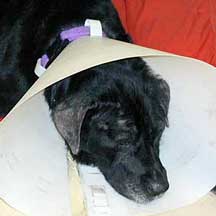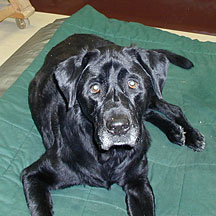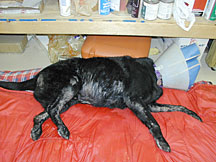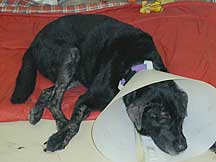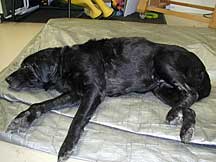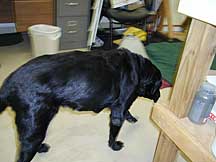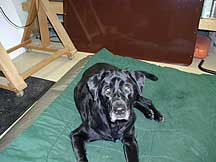
Max WITH LIVER DAMAGE & YEAST INFECTION TROUBLES
Discover how this Black Labrador Recovered from Yeast-related Skin Problems while also Struggling with On-going Liver Disease & Related Treatments |
Click Here for: Yeast Cleansing Instructionals
MAXIMILLIAN and his Long, Very trying Battle with Liver Problems and Skin Problems |
Breed: Labrador retriever
Age: 14 years - See page bottom for update (Max passed in May of 2007, succumbing to accumulated liver damage).
Problems: Allergies, Hypothyroid, Yeast Infection, Liver problems, Itchy skin, Chewing feet, Hair loss, Lethargy, Hepatitis C, Ear infections, Immune deficiency, and Odor
August 9, 2006 - Story Submittal:
Begin Chronological History
For the last several years, Max has been showing elevated liver enzyme levels in blood tests, indicating liver problems. General care through our vet in Pleasant Valley, NY first brought this condition to light. A biopsy of his liver was suggested, but declined. The Vet explained it could be hepatitis, a common problem in older dogs of the black lab breed.
In July of 2005, a large "carbuncle" type growth on the back of Max's rear left leg became large enough to cause concern. It was oozing pus and appeared infected. An office visit to the Vet confirmed this. He was prescribed antibiotics and scheduled for surgery to remove the carbuncle growth at the end of his antibiotic treatment. In a few weeks in early August 2005 the carbuncle growth was surgically removed.
August 2005: Two weeks after surgery, Max was experiencing skin problems with infected pustules breaking out on his belly. His belly was itching and Max was scratching constantly. He began to smell bad. Max was again taken to the same Vet where he was again prescribed antibiotics and Prednisone, a dangerous glucocorticoid class hormone that can affect his liver. His itching subsided, and the infections appeared to be clearing.
Mid September 2005: A few more weeks went by, (now September) and the problem returned. This time he was taken to a Pet Hospital in the Town of Poughkeepsie. Blood was drawn for testing, and skin scrapping were taken to look for mange and parasites, with none found. More antibiotics and prednisone were prescribed. This new vet called a few days later and stated that Max's liver enzymes were high. They had jumped from an average 300 prior to the previous surgery to now in the 500-600 range. (Prednisone liver damage was suspected).
October 2005: Several weeks went by with Max in what seemed like a remission from his itching skin infection problems. Then he started itching and scratching again, with copious amounts of hair falling out. The skin on his belly was bare and peeling like when a human has a bad sunburn. His ears were nearly bald. I found a spot on his back where loose hair was sticking out in a clump. I gave the hair a small tug, and a large patch of his fur and skin easily came off about 3 inches in diameter, leaving a large circular hole on his back covered in yellow pus. It smelled bad too. This shocked me and I thought maybe he had a ringworm infection. Max was again taken back to the pet hospital where a ringworm test was done and this proved negative. The area of the infection on his back between his front shoulders was clipped, and topically treated with hydrogen peroxide. The vet said his immune system appeared impaired due to his high liver enzymes indicating liver problems. More blood tests were ordered in a search to rule out cancerous tumors in the lymphatic system, and an ultra sound was scheduled to look for any mass on his kidneys or liver. All turned out to be negative. So, more antibiotics and prednisone were prescribed again.
I questioned the vet about the safety of this line of treatment and was told this was how it was done in these cases. It was suggested by the vet that maybe he was having allergic reactions to his environment or food. I dismissed this suggestion because Max had been on the same IAMS dog food for years and his environment had not changed either. In addition they prescribed Marin and Denosyl, food supplements with vitamins and antioxidants to aid the liver.
It was discovered at this point in a blood test that Max had a low thyroid problem and the hormones that are usually produced were flat (missing). He was prescribed Soloxine to help. The vet bills were mounting and my finances were feeling the pinch. We had spent over $2,000 from August to October, and Max was still sick. Tests done by the vet came back from the lab and the vet ruled out many other possible complications causing his liver problems and suggested Max had acute Hepatitis C (non contagious).
Max was taken home and given medicated baths, topical treatment with peroxide, oral antibiotics, prednisone, Marin, and Denosyl as prescribed daily, until these medications were gone. I had also clipped the fur on his throat, as another infection was found there. In the ensuing month, Max made a remarkable turnaround. The itching stopped, and the hair grew back on his ears. His belly seemed to be healing nicely too. We thought it was finally over but, this was short lived optimism.
December 2005: The itching came back, the smell came back, and the infections came back. I was skeptical about going back to the vet clinic again, as all the money we had thrown at this problem had not helped. I began treating Max with once a week medicated baths and topical treatments of hydrogen peroxide, and various anti-fungal medications sold over the counter for athlete's foot, ringworm, and jock itch. He had been chewing his legs to the point where they went bald and bloody. We had no choice but to put a large plastic cone over his head and onto his neck. The cone covers his head and prevents him from chewing on his body. He seemed to be responding to these topical treatments in that it kept the smell down, and when pustules broke out, they were healed quickly.
Mid January 2006: Max did not recover. He seemed to be getting worse and going down hill with his health. The topical treatments were no longer helping. Max was suffering with itch and odor. In desperation, he was taken back to the vet at Pet Hospital. More blood tests were done. More antibiotics and prednisone were ordered. I protested, but again was told, there was not other way to treat this. The vet said Max was fading fast and that we might consider his future and his suffering. To me this was a veiled suggestion of putting Max down. So, we put max back on the medications along with Soloxine, Marin, and Denosyl, and continued with the baths to keep his condition in check, but he was not improving nor worsening, as time went on. He is lethargic and lays around all day sleeping between fits of attempted scratching.
Late February 2006: A follow up visit to the vet and further consultations revealed Max was diagnosed with chronic liver hepatitis. It was explained that this was why Max had recurring infections, and that it was due to his compromised liver functions, and immune system. I was told he had to stay on Soloxine and Prednisone for the remainder of his life, and his life expectancy was not good. Max was taken home and his medications were continued. He started to look worse and his suffering had not subsided.
Late March 2006: I started to research his problem on the internet, and came across a site called NZYMES.COM. They had a great amount of information about Systemic Yeast Infections in dogs, what causes it, and a program they've developed to help clear the body of the yeast & toxins that produce the symptoms. They showed how antibiotics can hinder the repair process and become the major culprit that kills off the friendly bacteria flora in the intestines, giving rise to a runaway overproduction of yeast growth, a type of fungus that antibiotics do not kill. The friendly bacteria found in the intestines of animals and humans help to keep the yeast growth in check, or in balance. Once the overgrowth of yeast penetrates the intestines and enters the blood stream (leaky gut syndrome), skin infections in dogs occur where excessive biting and chewing goes on, scratching, hair loss, pustules, horrific odor, etc. They warned that vets often prescribe prednisone for the itch and inflammation and that this often contributed to a further breakdown of the GI tract. They also pointed out that prednisone has been shown to cause liver damage that worsens the condition.
They described a multitude of symptoms and many matched exactly what Max was going through. They offered products and detailed a Healthy-Skin Program that (also) required a change in food. They listed many foods that had to be eliminated because they were high in starchy carbohydrates which can feed the yeast growth. They recommended a high multi-protein meat-based diet from within the recommended foods list. 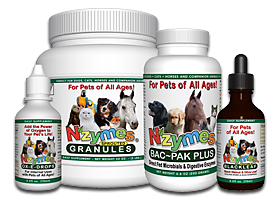
The customer testimonials at their site, and there were many, seemed remarkable. I read everything and then printed it out and read it again a few more times. I then ordered the Large Healthy-Skin Kit which included a combination of their high protein, vitamin enriched NZYMES® Antioxidant Treats and NZYMES® Granules, OX-E-DROPS, Tincture of Black-Leaf(a black walnut olive leaf herbal solution) plus the BacPak Plus pro-biotic supplement powder for regeneration of friendly flora in the intestine, all to add to Max's food.
Mid April 2006: I took Max back to the vet for a general exam and discussion with the vet about the NZYMES.COM print outs. The results of his last blood test for liver enzymes indicated that they had climbed over 1,200. Max was holding his own, but not getting better. He smelled bad and would still break out with open sore infections that were immediately treated with peroxide and antiseptic ointments which healed the sores quickly. His legs were bald in places. His ears had patches of fur missing. (see photos below)
They said I would receive the yeast kit products in a few days. I announced to my vet I was going to try this holistic approach to Max's problems and that I believed he had the "leaky gut syndrome" as described on the internet site. I also informed the doctor that I had taken Max off of all antibiotics and prednisone, as I believed it was doing more harm than good. I would continue Max on Soloxine to assist his thyroid condition as well as Marin and Denosyl to help his liver. The vet seemed genuinely interested and asked that I keep records of Max's progress. I left the NZYMES.COM print outs with this vet, and he indicated he would read up on it, while explaining to me that veterinary schools do not teach about food and holistic approaches to this kind of skin disorder, they teach only medicine.
April 20, 2006: Max was started on the NZYMES® Health-Skin Kit supplements today according to the strict instructions that came with the kit. He is given 4 NZYMES® treats per day, 2 in the morning and 2 in the evening. He is given Ox-E-Drops in his food and water as recommended. He is also given the NZYMES® Granules in his food. We were instructed to wait 2 weeks before giving him the Bac-Pak Plus pro-biotic supplements to promote healthy flora. These first two weeks are described as system cleaning time. We are warned by the instructions that his condition will worsen before he shows signs of improvement, and that it could take 3 to 7 months for complete healing.
We continued Max on his Iams dog food diet because the nutritional content statement on the bag appear to be similar to that given for the more expensive foods recommended by the NZYMES.COM site, and instructions that came with the kit. Little did we know this was a mistake.
Mid May 2006: Max's condition has gotten much worse, as the instructions predicted it would. Though it does not happen to all dogs Max experienced diarrhea the first week as part of his internal cleansing. Most of his belly hair was now gone. His ears, head, face, and neck are bald with the skin blackening. He has patches of fur missing from his hind quarters and legs (see photo). The smell is horrific and his weekly baths have not seemed to help for more than a day. There is dried yellow crusty pus all over his back beneath his fur, but surprisingly, no open sores. It's as if the yeast infection throughout his body is oozing from every hair follicle of his skin. We continue to spray him with an Ox-E-Drops 2% solution in all the infected areas multiple times per day. We expected this condition to happen, but not this bad. It scares us and we wonder how long it will take.
Late May 2006: No improvement whatsoever. We have decided to get the food recommended by NZYMES.COM. We located the second listed brand (recommended foods) stocked locally by an animal feed store. Max took to it right away and seems to love it. We continue his daily care as instructed.
June 5, 2006: After about 3 months, Max is finally starting to show small signs of improvement! Hope at last. His hair is starting to grow back on his ears, and the ear skin color has changed from deep black to gray. His baths continue once a week and are controlling the smell now for 3 days before it comes back. Some hair growth is noticeable on his belly (see photo).
June 18, 2006: The re-growth of hair is definitely happening. We removed his cone from his head for awhile today. An hour went by before he started biting his hind legs again. The cone went back on. Still an improvement, though. A few weeks ago, it took only minutes with the cone off before he started biting and chewing his legs. The odor hasn't stopped except for a few days after a bath. I now mix several medicated dog shampoos together to increase the benefits of each into one solution. The shampoos that are mixed together are: Sulfadene Shampoo (contains sulfur and coal tar), Malaseb Shampoo (anti-fungal), Chlorhexiderm 4% Shampoo (antiseptic), and Johnson's Baby Shampoo. To this blend, I add an ounce of Tincture of Black-Leaf solution, and an ounce of Ox-E-Drops (2%) solution. After lathering Max over his entire body, getting it all down to his skin, I leave it on him for 25 minutes before rinsing. (NOTE: This is NOT the Nzymes.com RECOMMENDED PROCEDURE for shampooing). This is proving to be an excellent method and he stays clean now for a week before the smell comes back. The occurrence of the pustule outbreaks have thinned to only a few on his back between baths.
July 4, 2006
Max's recovery is remarkable. He is definitely getting better, week by week. He is not completely recovered yet, as he still needs a medicated bath once a week. He also shows signs of needing to itch every once in a while. However, his skin infections are few and far between. His hair is growing back steadily, and he can now go for hours without his cone and without biting or chewing. Still, if left alone without his cone on, he will go back to chewing. See pictures taken today below. We continue his daily regiment of supplements and Ox-E-Drops 2% solution sprays. We also add Ox-E-Drops to his food and drinking water. I just ordered another Yeast Kit (Healthy-Skin Kit) for large dogs, as supplies of his supplements are low.
July 10, 2006: Max had his cone off yesterday for at least 6 hours and did not bite or scratch. Before putting him to bed for the night, his cone went back on for insurance. Two days ago, I noticed an infection was again inside both ears. I used an ear wash for dogs, and then cleaned them with cotton swabs on wooden sticks. I then swabbed them with triple antibiotic ointment in the ear canals. He was occasionally whimpering in pain last night until I gave him an aspirin which seemed to work. This morning, his right ear looked good, but the other one was still red with irritation. I will repeat the cleansing and treatment today.
Notice the improvements in his ears and belly. His back leg shows where he chewed recently when left unattended with his cone off. Another sign of improvement is he now wants to go out and play fetch with his ball every day for the last few weeks. Before that, he would not be interested or bothered, preferring to lie around and sleep most of the day. (Click Photo for Large Image) |
July 15, 2006: After 3 more treatments Max's left ear infection is now gone. These last 3 treatments, Otomax ointment was used to help resolve the ear infections.
July 29, 2006: All of Max's hair and fur has grown back. There has been no smell or infections on his skin for the last 2 weeks. He seems happier now that he has not had to wear the protective plastic cone over his head and neck. He is no longer chewing or biting, the worst is finally over, but the people at NZYMES.COM suggest that it will take several more months, perhaps the rest of the year before his GI tract and the pH imbalance will be resolved. When I scratch his belly, he no longer kicks his foot as if he were doing the scratching. The same for all other areas of his body, except one small spot on his back. He will be getting another medicated shampoo bath today, which should eliminate that small problem. I am continuing to give Max his NZYMES® supplements with his new food to continue his health maintenance. He is also continuing to get his liver health supplements and his medication for his thyroid. From the photo your can see how nicely his fur has grown in and how shiny and healthy it now looks.
It has been nearly 4 months since we started Max on the new food, NZYMES® supplements, his liver supplements, and thyroid medication. I am grateful I found the NZYMES.COM internet site, and wish that all veterinarians could some how be educated to recognize yeast infection symptoms and this wonderful treatment system for a cure. The teaching of vets in medical school has somehow overlooked the phenomenon of the "leaky gut syndrome" in dogs and how it can be linked to antibiotic use. This was NOT an allergy condition as many vets claimed, as well as several internet sites. The use of prednisone by vets in treating the symptoms is just that, a way to deal with the symptoms and not the real problem. Ongoing use of steroids can be dangerous to the health of the dog's liver and immune system.
August 4th, 2006: I took Max to the vet today to get a blood test and general exam. I am curious as to his liver enzyme problems that were elevated to over 1200 back in March and if they had come down. The vet was thrilled when he saw Max and how well he was doing with his skin problems which are now completely healed. I went over the process of what I had been doing with Max to improve his skin condition and that "leaky gut syndrome" was the cause. He was totally into what I was telling him and asked for a copy of this report. I asked him to share this information with his colleagues and any vet organizations he belonged to. He said he would.
August 7, 2006: The vet called today with very good news on Max's blood test. His total liver enzyme count had come down into the 600s from the previous 1200, a 50% improvement. The ALT enzyme count had come down from over 300 to 144 (normal is below 100). The vet said to keep doing what I am doing, it's working! His thyroid hormones were in the normal range, due to the Soloxine medication that he continues to get daily. Max is doing great with his skin and fur, and we will continue his NZYMES® Yeast-Kit supplements with his current food until at least the end of this year. He will then be evaluated again.
It has been nearly 4 months since we started Max on the new food, NZYMES® supplements, his liver supplements, and thyroid medication. I am grateful I found the NZYMES.COM internet site, and wish that all veterinarians could some how be educated to recognize yeast infection symptoms and this wonderful treatment system for a cure. The teaching of vets in medical school has somehow overlooked the phenomenon of the "leaky gut syndrome" in dogs and how it can be linked to antibiotic use. This was NOT an allergy condition as many vets claimed, as well as several internet sites. The use of prednisone by vets in treating the symptoms is just that, a way to deal with the symptoms and not the real problem. Ongoing use of steroids can be dangerous to the health of the dog's liver and immune system.
August 4th, 2006: I took Max to the vet today to get a blood test and general exam. I am curious as to his liver enzyme problems that were elevated to over 1200 back in March and if they had come down. The vet was thrilled when he saw Max and how well he was doing with his skin problems which are now completely healed. I went over the process of what I had been doing with Max to improve his skin condition and that "leaky gut syndrome" was the cause. He was totally into what I was telling him and asked for a copy of this report. I asked him to share this information with his colleagues and any vet organizations he belonged to. He said he would.
August 7, 2006: The vet called today with very good news on Max's blood test. His total liver enzyme count had come down into the 600s from the previous 1200, a 50% improvement. The ALT enzyme count had come down from over 300 to 144 (normal is below 100). The vet said to keep doing what I am doing, it's working! His thyroid hormones were in the normal range, due to the Soloxine medication that he continues to get daily. Max is doing great with his skin and fur, and we will continue his NZYMES® Yeast-Kit supplements with his current food until at least the end of this year. He will then be evaluated again.
UPDATE 5/29/07: After our reply to hearding about the loss of Max --
Thank you for your kind words. Only responsible pet owners can understand our deep attachment to our dogs. Max was the greatest dog I ever owned. He was very smart, loyal, and obedient. He had a good life and gave us his unconditional love for nearly 14 years. I understand that is a pretty good age for a black lab. He did outlive the other black labs in our neighborhood (2 others).
We knew for the last 5 years that he had liver problems. He had been diagnosed with chronic hepatitis, which one vet described as common in older black labs. My understanding is that his liver problems affected his immune system, so we kept watch for any infections. He had an infection in a carbuncle he had removed 2 years ago, and was given heavy doses of antibiotic, which I believe caused his yeast infections. The prednisone he was prescribed at the same time didn't help his liver either, and probably damaged it more. Max was also taking Soloxine for his thyroid, which had ceased functioning a few years ago.
When he had his yeast infection, we thought that was the end. But the NZYMES® Yeast-Kit treatment we used from your web site and the food change that was recommended on your site, really did work and cured him of that problem. Once the yeast infection was gone, it did not come back. At the same time that he was treated with the NZYMES® system, we gave him supplements to help his liver (S-adenisil and Marin).
After his yeast infection was cured, and he grew a new coat, I took him to the vet for a blood test on his liver enzymes. The vet was actually shocked and amazed at how healthy Max looked. His liver enzymes blood test came back with very good news. His bad liver enzyme count had dropped from 1200+ to 150. The vet said what ever you are doing keep doing it.
We kept max on the yeast program for about 8 more months. Last December, Max started to show serious signs of aging. His hearing started to go, and he seemed confused at times. He started sleeping a lot more during the day, as well as all night, with brief periods of activity during the day. He hung on for another 4 months, slowly going down hill. We knew it was a matter of time, and one day he would let us know. He was happy and comfortable right to the end. On the morning of April 16, 2007, Max succumbed to his weakened liver. He went outside to do his morning routine "business" as usual, and then came in and laid down by the fireplace on his bed. I made his daily meal to feed him, and for the first time in his life, he did not get up again to eat. I tried to help him up, but he collapsed and fell back down. He laid his head down, and did not have the strength to lift it again. I called the vet, and then carried him to the car. He was carried inside the vet's examining room, where Max managed a little tail wag as he was laid on the table. His eyes were now glazed over into a stare. The vet said he would not last the day. He was then put to sleep as I stroked his head for the last time.
Max gave us many years of wonderful love, memories, and fun. He will never be forgotten. It's rare to find a dog that had absolutely no bad dog behaviors right up to the end. He loved people and children, always wanting a pat on the head, and always wanting to play and retrieve. We will miss him for a long time.
Again, thanks for your kind words. We will also never forget the wonderful help we got from your products. Your system helped keep our Max healthy for another year.
Sincerely,
William and Cynthia Ofca, Hyde Park, NY
